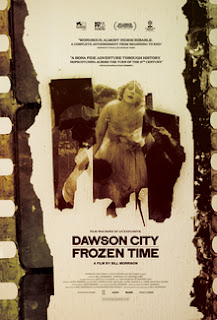Dawson City: Frozen Time
Dawson City, in the Yukon territory of Canada, was the epicenter of the Klondike gold rush of 1897-1898. It went from a native American fishing camp to a city of 40,000 almost over night. Few hit it rich by gold strikes, but the enterprising got rich by selling to the miners. That included entertainment, and Dawson City had a number of movie theaters, where silent films were a big attraction.
Dawson City was the end of the line in film distribution, and when it came time to send the films back the distributors didn't want them. So some films ended up in the Yukon River, some were burned, but a great deal of them ended up filling in a swimming pool, and weren't found again until 1978.
It is estimated that 75 percent of silent films have been lost. But Dawson City turned up a treasure trove of them. The films found, some in bad shape but still viewable, were restored. A total of 372 films that were thought to be lost find life again.
This is the subject of Bill Morrison's fascinating documentary Dawson City: Frozen Time. He tells the story of the films, all the while giving us numerous glimpses of those films. Usually they are given to us thematically--if someone talks about calling someone on the phone, we get scenes of actors on the phone, and so on. It's clever and must have been painstaking work.
These films have a ghostly quality. You may realize that everyone in them are long dead, but in addition to that the black and white nitrate film gives them an otherworldly look. It's like looking into the past.
A number of interesting people pop up during the film, associated with Dawson City. Fred Trump, the current president's grandfather, started the family fortune by running brothels (insert your own joke here). Future theater owners Sid Graumann and Alex Pantages spent some time here, the former working as a paperboy and the latter opening his first theater.
Today Dawson City has just a few thousand people and has a modest tourist trade. There is no movie theater. But, as this film shows, it was once a great place to see a movie.
Dawson City was the end of the line in film distribution, and when it came time to send the films back the distributors didn't want them. So some films ended up in the Yukon River, some were burned, but a great deal of them ended up filling in a swimming pool, and weren't found again until 1978.
It is estimated that 75 percent of silent films have been lost. But Dawson City turned up a treasure trove of them. The films found, some in bad shape but still viewable, were restored. A total of 372 films that were thought to be lost find life again.
This is the subject of Bill Morrison's fascinating documentary Dawson City: Frozen Time. He tells the story of the films, all the while giving us numerous glimpses of those films. Usually they are given to us thematically--if someone talks about calling someone on the phone, we get scenes of actors on the phone, and so on. It's clever and must have been painstaking work.
These films have a ghostly quality. You may realize that everyone in them are long dead, but in addition to that the black and white nitrate film gives them an otherworldly look. It's like looking into the past.
A number of interesting people pop up during the film, associated with Dawson City. Fred Trump, the current president's grandfather, started the family fortune by running brothels (insert your own joke here). Future theater owners Sid Graumann and Alex Pantages spent some time here, the former working as a paperboy and the latter opening his first theater.
Today Dawson City has just a few thousand people and has a modest tourist trade. There is no movie theater. But, as this film shows, it was once a great place to see a movie.



Comments
Post a Comment